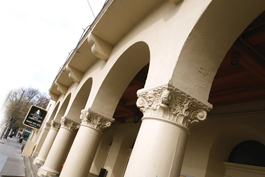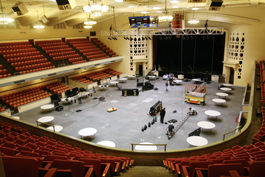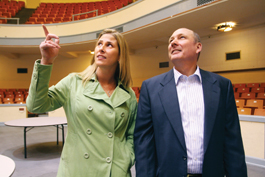home | metro silicon valley index | features | silicon valley | feature story

Photographs by Felipe Buitrago
Rebuild This Civic On Rock & Roll
The city wants to restore the Civic to all its former glory as a South Bay venue on a par with the Warfield and the Fillmore. If they fix it up, can embattled Team San Jose fill it up?
By Mike Connor
A COUPLE of years ago, Live Nation, one of the world's largest concert promoters, came knocking on the door of the San Jose Civic Auditorium in hopes of adding the venue to its roster. Team San Jose, the organization contracted by the city to run its venues, turned them away.
When Lee Smith, chairman of Live Nation San Francisco and Denver, talks about it now, it's clear from his tone that the negotiations over the Civic left a bitter taste in his mouth. "It wasn't a pleasurable experience," he says.
With the help of Mayor Chuck Reed, Team San Jose is getting $10 million to turn a renovated Civic into what city leaders conceive of as a venue on a par with San Francisco's Warfield and Fillmore. The advantages to contracting out to Live Nation, the company that actually runs the Warfield, and the Fillmore seem obvious. So why not sign an exclusive contract with the company that books them?
"A lot of discussion has been had around that topic," says Chuck Ryder, director of arts and entertainment for Team San Jose. "At this point it doesn't make sense to go to an exclusive promoter. We're open to promoters—they all get the same deal, they all have the same opportunity." So Team San Jose has decided to strike out on its own with the Civic renovation project. In turning down Live Nation, it committed to what seems like a more democratic plan. But the city's Civic team could quickly learn that the music biz is all about heartbreak. For instance, they'd love to work with Live Nation under Team San Jose's terms in the future, but what would make the megapromoter pick up the phone and call the Civic to book a show there?
"Well," says Smith, "nothing."

Bid for Credibility
Team San Jose is a private nonprofit organization created in 2003 to manage the city's cultural facilities, including the Convention Center, the Civic Auditorium, the Parkside Hall, the South Hall, the Center for the Performing Arts, the California Theatre and the Montgomery Theatre.
TSJ won the five-year contract to manage those facilities in a competitive process, but, according to the 2006 Santa Clara County Civil Grand Jury Report, it won the contract unfairly, and then failed to meet its performance goals over the past three years.
The report says that TSJ underestimated its losses during the selection process and then, during the management agreement negotiations, revised them to be nearly identical with one of the losing bidders. As the report puts it: "TSJ was granted the right to enter exclusive negotiations for this contract based in large part on its significantly lower projected cost to the city over the term of the contract. Global Spectrum was ranked second in the evaluation process and projected a five-year loss of $9.7 million. Information provided by the city during the negotiation process allowed TSJ to more than double its projected loss so that its financial projections were then equivalent to [those of] Global Spectrum. None of the other responders was allowed to provide a revised proposal based on this new information."
The grand jury also took issue with Team San Jose's cooperation with the Convention and Visitors' Bureau, a city-funded entity on which it offloaded marketing responsibilities without including those additional costs in its projected expenses.
And despite the fact that TSJ has lost $2.8 million more than it had projected for the first two years and expects to lose $8.6 million more than it had projected for the last three years, the city opted to stick with TSJ for the remainder of their contract on the basis of statistics showing improved visitor attendance, which has a multiplier effect throughout the local economy as event attendees spend money at local hotels, restaurants and shops.
In his budget message in January, Mayor Chuck Reed announced an allocation of an additional $8 million to the existing $2 million for an upgrade to the Civic Auditorium. City officials believed that bringing in a new operator now would only complicate the renovation that is already under way.
Master Plan
Team San Jose has worked the Civic into their strategy for managing its collection of venues. Given its proximity to the Convention Center, the Civic can be used as an adjunct venue during the week without interfering with its weekend use as a concert venue, maximizing usage. And by operating all four theaters as a "theater district," TSJ has positioned itself as a sort of one-stop shopping point for promoters in search of a local venue. So, for example, you might call them with an interest in the Civic, but if you were only expecting 500 people to turn out at your event, they could redirect you to the more intimate Montgomery Theater.
And by booking with an eye toward a diversity of performances, the local demographic can, in theory, be better served by TSJ than by a private promoter focused only on the bottom line.
"The vision for the Civic is to get the highest and best use for the community, says Ryder, "We've gone to the entertainment industry and talked about a closed or an exclusive promoter arrangement, and the industry feels that that's not the best way to go. ... We're not just a single demographic, so the best thing for us to do is to allow everybody to book the theater, that gives us the ability to bring in more shows and more different kinds of shows."
Ryder says he's well aware that concert promotion is a risky business that, in addition to guts, requires experience and knowledge of a target market. He was hired last March as a national sales manager, but was recently asked to move into his current position as director of arts and entertainment because of his experience in the concert industry—Ryder used to book the summer concert series at the Santa Cruz Beach Boardwalk, and also worked as the director of booking at the HP Pavilion for over three years.
Ryder, in turn, hired Annie Mogensen to work the booking calendar and the contract and insurances processes for the theaters, but she's also undertaken a project in conjunction with San Jose State University students to identify key demographics in the area, what shows and genres of music they want to see, and some of their spending habits, all in an effort to better identify the target market for the Civic.

Hopes and Fears
Councilmember Sam Liccardo, who represents the downtown district, is optimistic about the Civic, but he's circumspect when it comes to Team San Jose.
"I'm taking a wait-and-see attitude," says Liccardo. "This is not an area where they have a lot of experience and so I want to give them a chance and we'll watch carefully."
Mayor Reed is more enthusiastic.
"The question is, how best to program it?" asks Reed, rhetorically. "And I don't think we know the answer to that yet, but I think Team San Jose is certainly capable of it. They may need to subcontract out a part of it, but they're working with a lot of vendors and folks. I'm very optimistic about the ability to increase the usage a lot, which is the basic objective."
Bookings at the Civic are on the rise—and despite Smith's skepticism even include Live Nation shows. Scheduling will remain relatively sparse for the next two years, however, to allow for renovations. And the Civic needs a lot of them.
Dean Monroe, the chief of staff at the City of San Jose Redevelopment Agency, doesn't mince words when it comes to the city's run-down assets.
"The city has a way of not taking very good care of its buildings," says Monroe. "The HP Pavilion is a notable exception, but the same with the Convention Center—the city lets its buildings get run down."
Speaking directly to a modern audience's expectations, Monroe says, "People want to see a great show, but they also want to view the show in comfort, in a very nice, Disneyland-like surrounding. That's what HP Pavilion is so good at. That's what we have to re-create there—a facility with Disneyland-quality amenities."
The Civic opened in 1936, and Monroe refers to it as "our HP Pavilion in the pre– and post-–World War II years." He calls it "one of the best concert venues on the peninsula" during the '60s, a venue that hosted the Rolling Stones, the Byrds and presidential candidate Richard Nixon, among many others.
"It hasn't been painted since 1984," says Monroe. "Our hope is that with a series of improvements, including painting, it will again be a magnificent building, it will sparkle once again and be an incredible asset to the downtown."
But is $10 million enough to accomplish all their goals?
"Oh, I think we can get almost all of the way through," says RDA project manager Bill Eckern. "Unless we hit a real surprise that we have not seen yet, I think that $10 million gets us all of the infrastructure that we've identified, which is to make the building comfortable and functional. I think it provides upgrades to things like the sound system and the lighting and restrooms, all of the things that make it usable as a space."
While it may be usable after the renovation, $10 million might not be enough to get the sparkle they're after.
"No one's gonna be happy with a building two-thirds restored," says Monroe.
Team San Jose is hopeful that the $10 million will go the distance, because it's those finishing touches that could make or break the venue. But if the RDA and Team San Jose need to ask for more money from the council, Liccardo, for one, is aware of the possible shortfall.
"We're still sorting through the estimates for the renovations," says Liccardo, "but the money that we've allocated at this point in the budget looks like it could be gobbled up entirely in handling a lot of internal HVAC and back-of-stage improvements that won't necessarily enhance the appearance of the Civic, which is obviously what we want."
Concert promoter Bruce Labadie believes that the $10 million just isn't going to be enough.
"The amount that the city has proposed to use for that upgrade, in my opinion, is not enough, says Labadie. "The $10 million would go to infrastructure changes, but I think it needs about twice that much to bring it up to the standards of facilities in other cities, including some type of corporate or private areas, better concession areas and sound enhancements."
Open-Door Policy
As far as future profitability goes, while an exclusive deal with a partner like Live Nation might reduce your booking responsibilities and risk, it also reduces your control and your opportunities for ancillary revenues. But Smith sees potential pitfalls in the course Team San Jose has chosen, too.
"The issue with the Civic is that it will never compete with proprietary venues on a one-night-rental basis," says Smith, "with the promoter not having the ancillary revenues that I would ordinarily get at the Warfield, it being my venue."
Not that Smith actually owns the venue, but Live Nation's master lease lets him do pretty much what he wants with it.
"I have a master lease at the Warfield and I have a master lease at the Fillmore, and I operate those venues," says Smith. "That's significantly different than what the situation is at the Civic where I would call up and rent the facility for one evening."
If he does call up the Civic and rent it for an evening, the contract is structured so that the City gets a cut of food, beverages and merchandise sold during the evening.
"If the city were to keep all the food and beverage [profits], sponsorship opportunities and all the other things in addition to the risk and reward of just putting a show on sale and selling tickets," explains Smith, "it's never going to be competitive with a proprietary venue."
Meghan Horrigan, Team San Jose's director of public affairs, to change his mind.
"Live Nation is a great partner and we enjoy working with them," says Horrigan. "We look forward to booking more events in the future with them."
Will They Come?
If the renovation, promotion and booking all succeed beyond expectations, there's still the lurking problem of habits—as in, given the recent dearth in live music downtown, people aren't in the habit of going to shows in San Jose anymore.
Larry Trujillo, co-owner of the Blank Club, sees it as a psychological barrier.
"I love [the Civic]," says Trujillo, "but the problem is getting people to actually come out in San Jose. I was [at the Civic] when the Pixies played and it was two-thirds full. When Interpol played, it was two-thirds full. Every event that I've been to there that sold out everywhere else, it wasn't full."
Former local club owner Chris Esparza says that even with a dreamy outcome for the Civic, the question still remains: "Would South Bay audiences respond and actually show up? My brain hurts thinking about that question."
Similarly, Trujillo sees some responsibility on the part of local audiences.
"People have to start realizing that San Jose is becoming a 24-hour city," says Trujillo. "People are gonna have to do their part—stop going to San Francisco, stop staying in their living room and come out and see a show at the Civic."
And if this whole Civic project turns out to be a boondoggle, they can always hope that a previously spurned suitor like Live Nation might be waiting in the wings to save the day. Would they still be interested?
"How would I put this?" asks Smith, rhetorically. "I guess the answer is yes—if the situation were different." Different, how? "If [Team San Jose] were more amenable to the situation, to the scenario. If they were willing to seriously negotiate."
Send a letter to the editor about this story.
|
|
|
|
|
|